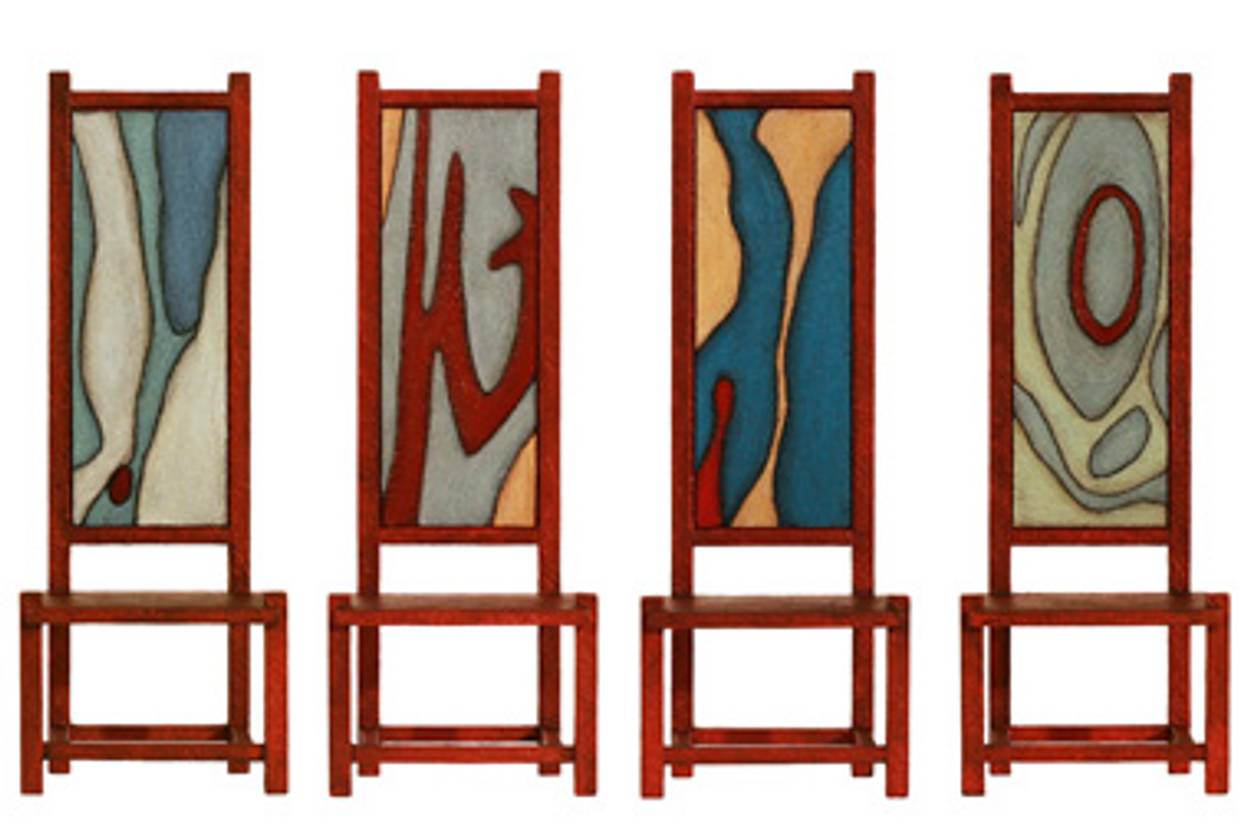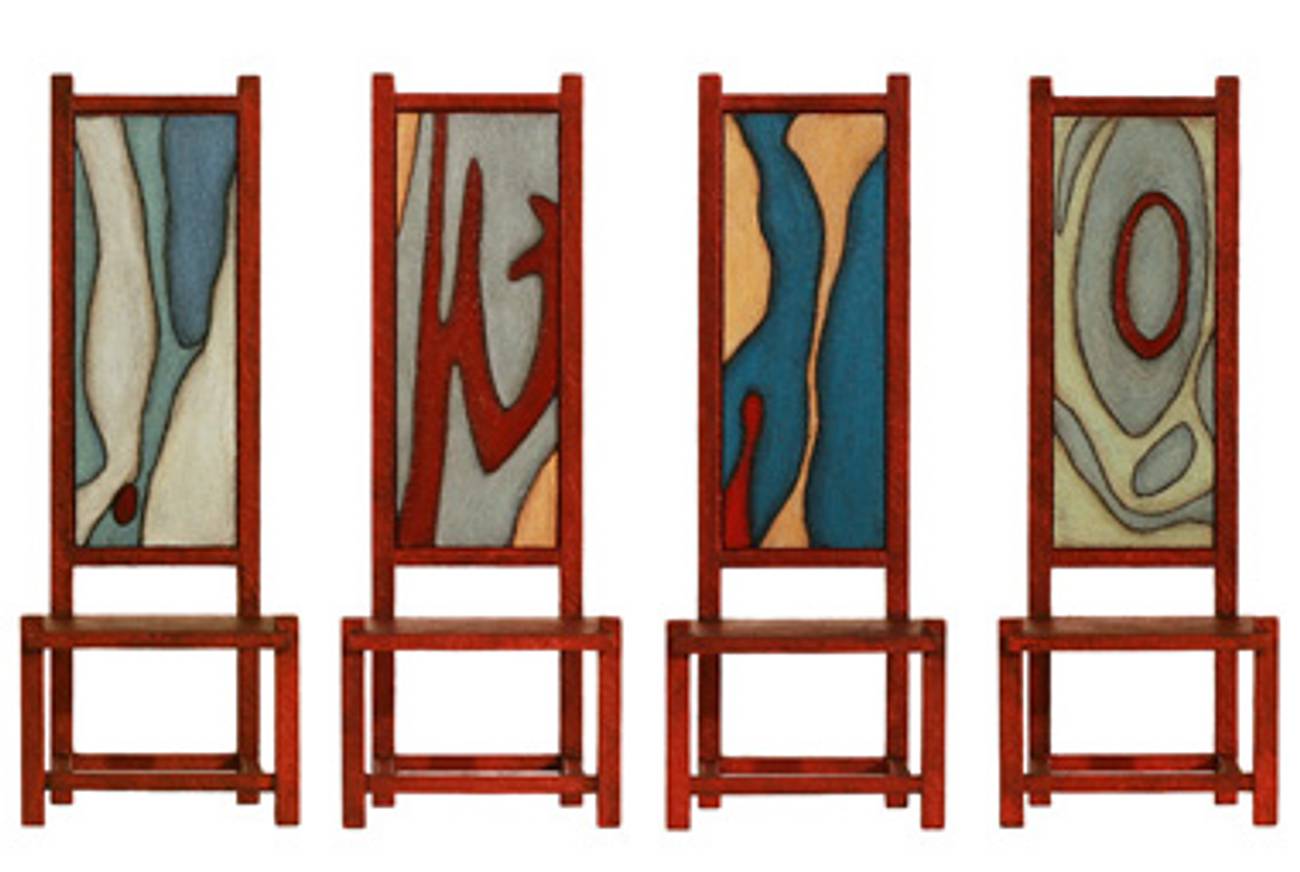Sacred Spaces
Tobi Kahn and the art of creative reverence




An old card catalogue stands in the Jewish Theological Seminary library—a behemoth from the pre-digital past. But with many of its drawers filled with abstract wooden forms by the artist Tobi Kahn, it has been transformed. Carved wooden reliefs evocative of ancient ruins are set within this tactile cabinet of knowledge, while other drawers overflow with their original yellowing cards typed in Hebrew, English, and a multitude of other tongues.
Kahn is the seminary’s first-ever artist-in-residence, and his embellishment of the now-antiquated card catalogue is one of an ever-growing series of works he has created at American Jewish institutions. The card catalogue is part of an exhibition of his works that will be on view at the library until January. Two other shows in New York currently feature Kahn’s art, one at the Jewish Museum and another, devoted to his sacred spaces, at the Museum of Biblical Art near Lincoln Center.
A sculptor and painter, Kahn has been designing sacred spaces like a meditation room at the HealthCare Chaplaincy on the Upper East Side, which provides spiritual care for patients of all religions in New York City hospitals; a just-completed Reform synagogue in Milwaukee; as well as newly installed ceremonial art for the Plaza Jewish Community Chapel funeral home and the Abraham Joshua Heschel School, both on New York’s Upper West Side.
Kahn calls himself a “reductive realist,” and his paintings are intended to echo the works of Mark Rothko and the 19th-century painters Caspar David Friedrich and Albert Pynkham Ryder. Yet unusually for a contemporary artist who has exhibited widely since his work was included in a Guggenheim survey in 1985, he is an observant Jew who spent several years at a yeshiva in Israel after completing studies at a Jewish day school.
Kahn grew up in the Washington Heights neighborhood of Manhattan as the son of refugees from Nazi Germany, and he recounts his childhood in strikingly aesthetic terms. “I loved Kol Nidre, because I remember everything being white,” Kahn said in an interview. “That was my first sacred space.”
Quick to cite artists he admires, Kahn often uses Jewish references in doing so. Speaking with reverence of the Rothko Chapel in Houston, he says that it’s best suited for reading Eicha, the Book of Lamentations. He calls installation artist James Turrell a “Gadol hador,” one of the “greatest of his generation,” a term usually invoked by religious Jews to refer to revered sages. Of his own work, Kahn says, “People ask me, am I a Jewish artist? I don’t believe in any of that. I believe that I’m an educated person. When I think about color theory, I think about Josef Albers, but I also think about how the Beit HaMikdash was created.”
Kahn’s is the finest piece in the Jewish Museum’s current exhibition “Reinventing Ritual”—a moveable wall sculpture of dark pewter-colored blocks used to count the 49 days between Passover and Shavuot in commemoration of the wandering in the desert before receipt of the Ten Commandments. Kahn’s austerely beautiful wooden peg board rivals the assemblages of Louise Nevelson and at the same time uses aesthetics and material culture to deepen religious practice.
The Museum of Biblical Art exhibit bears traces of a visit Kahn made years ago to Charleston, the riotously colorful English country home of Bloomsbury artists Vanessa Bell and Duncan Grant. This inspired a set of four multi-hued, high-backed chairs he created for mothers and grandmothers to sit on at the naming ceremony of a baby girl. The quartet corresponds to the four Biblical mothers, and contrasts with the two chairs used at a male circumcision; one a ceremonial seat for the prophet Elijah and the other for the newborn’s godfather.
Kahn’s ceremonial works break the mold of traditional Judaica, bearing little resemblance to the gleaming Kiddush cups used for generations to sanctify the Sabbath. Kahn’s art “unites our perception of the material with our memory,” says the art critic Dore Ashton. So instead of precious silver or delicate porcelain, Kahn has reimagined these items out of acrylic on wood, giving them a vaguely surreal aspect, perhaps to refocus the user’s attention on the substance and meaning of the ritual rather than solely on the object with which it is performed.
Now a 57-year-old father of three, Kahn has widened the array of ritual objects he has designed in response to his own experience. His designs cover birth through death, including the chairs for his daughter’s naming, his own marriage canopy, and a portable Torah ark used in a house of mourning. Kahn invents titles for all of his works that are vaguely Hebraic yet devoid of meaning—Lhayd, Vyhti, Ykarh, Yr-Hyla are a few examples. Is intentionally obfuscatory language helpful to American Jewry nowadays?
“I don’t like work that is illustrative,” he says of his ambitious project for Congregation Emanu-El B’ne Jeshurun in Milwaukee, where Kahn painted eight richly textured canvases with abstract imagery recalling amorphous shapes on a microscope slide and designed the ark doors, the eternal flame, candelabras, Torah breast plates, pointers used for reading the scrolls, mezuzahs, as well as Havdalah candle holders and spice boxes. Kahn avoids the use of recognizable symbols in this all encompassing environment, with the exception of the cast bronze eternal light that alludes to the shape of a pomegranate.
“I want the viewer to go on a journey,” he says. “I don’t want to spoon feed the viewer. I believe the viewer is an equal participant to the artist. I want people to come in there and feel the presence of something greater than themselves. If you can change the way you feel when you walk into a space, that’s what holiness is to me.”
Through workshops and courses at places like JTS, he wants to elevate visual sophistication and awareness. In addition to serving on the faculty of New York’s School of Visual Arts, Kahn teaches regularly at synagogues and day schools and is artistic director of the group Avoda that uses art to promote Jewish learning. “I am very upset that people don’t realize how important the visual is in Judaism,” he says.
“If you count the letters and words in the Bible, there is more written about the conversation between Bezalel and God and the whole idea of what angels should look like in the Holy of Holies than about keeping kosher. I will fight until the end of my life saying that Judaism is a visual language. Do I think that people portray it as that? Well, the truth is that if you’re fleeing from country to country, it’s easier to take your books than it is to take your menorahs because they’re easier to pack. We are a very knowledge-based religion and I love that, but one does not have to compete against the other.”
Michael Z. Wise is a contributing editor at Travel + Leisure magazine and has written on cultural topics for The New York Times, The Washington Post, the Los Angeles Times and ARTnews.
Michael Z. Wise, the author of Capital Dilemma: Germany’s Search for a New Architecture of Democracy, is a contributing editor at Travel + Leisure.
Michael Z. Wise, the author of Capital Dilemma: Germany’s Search for a New Architecture of Democracy, is a contributing editor at Travel + Leisure.